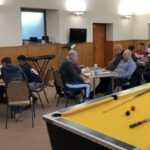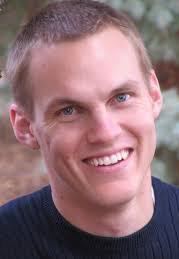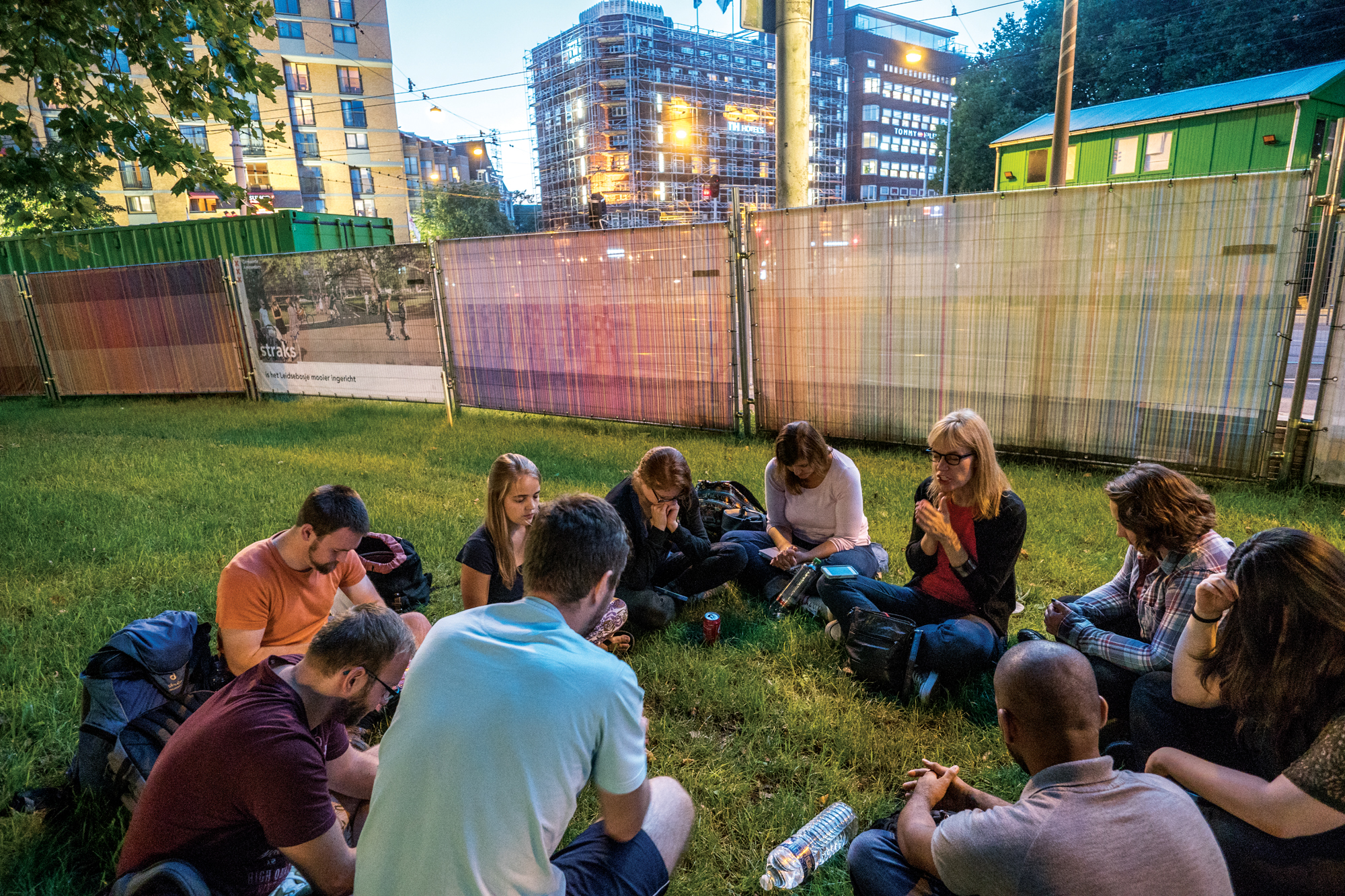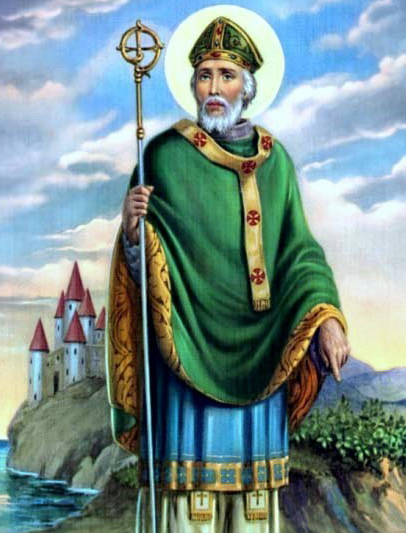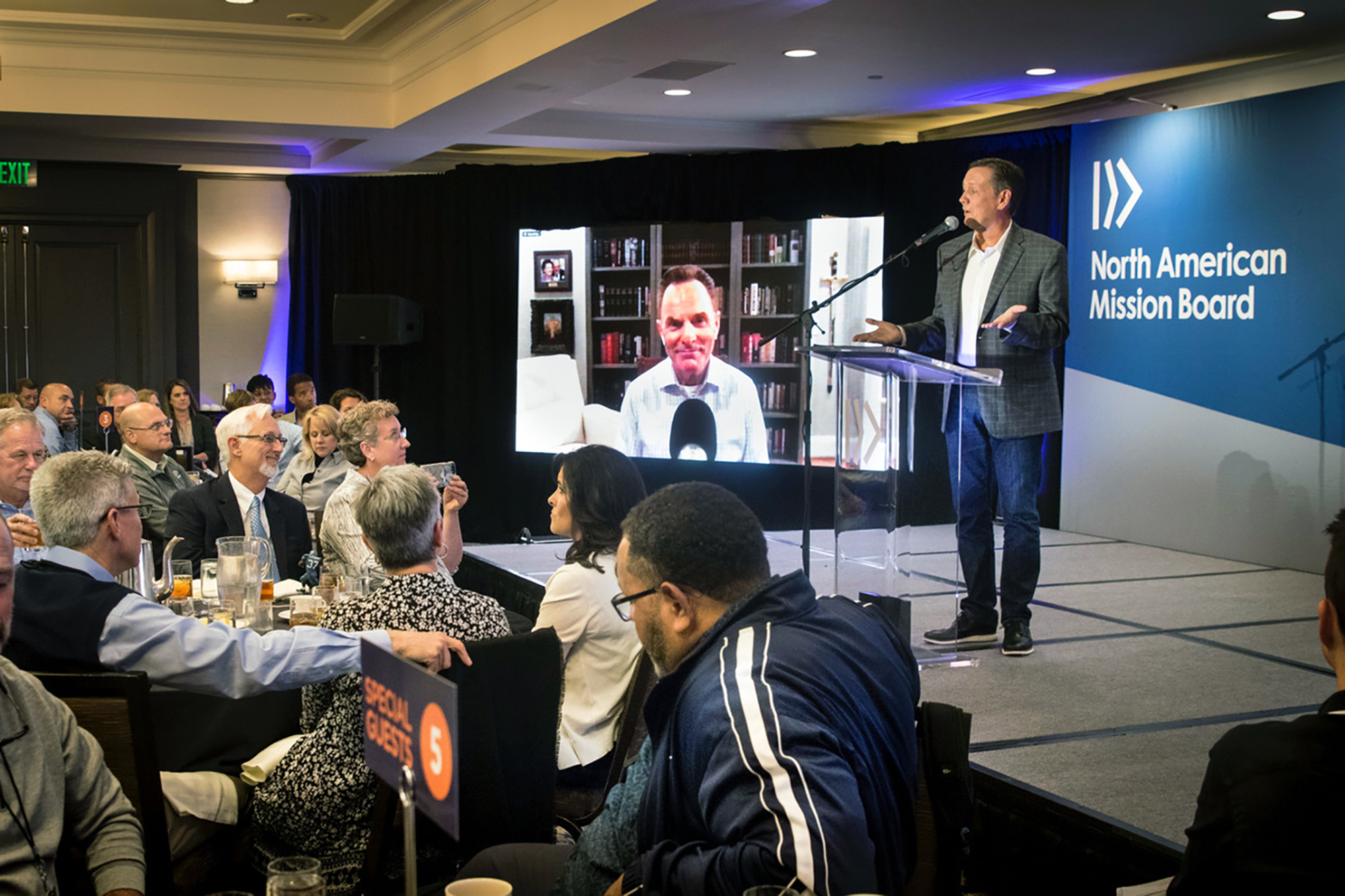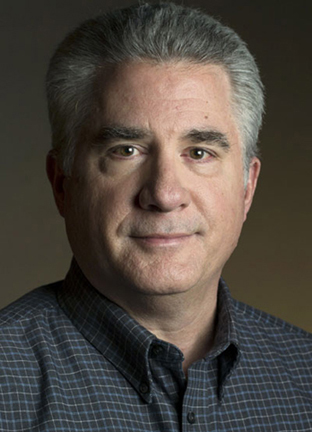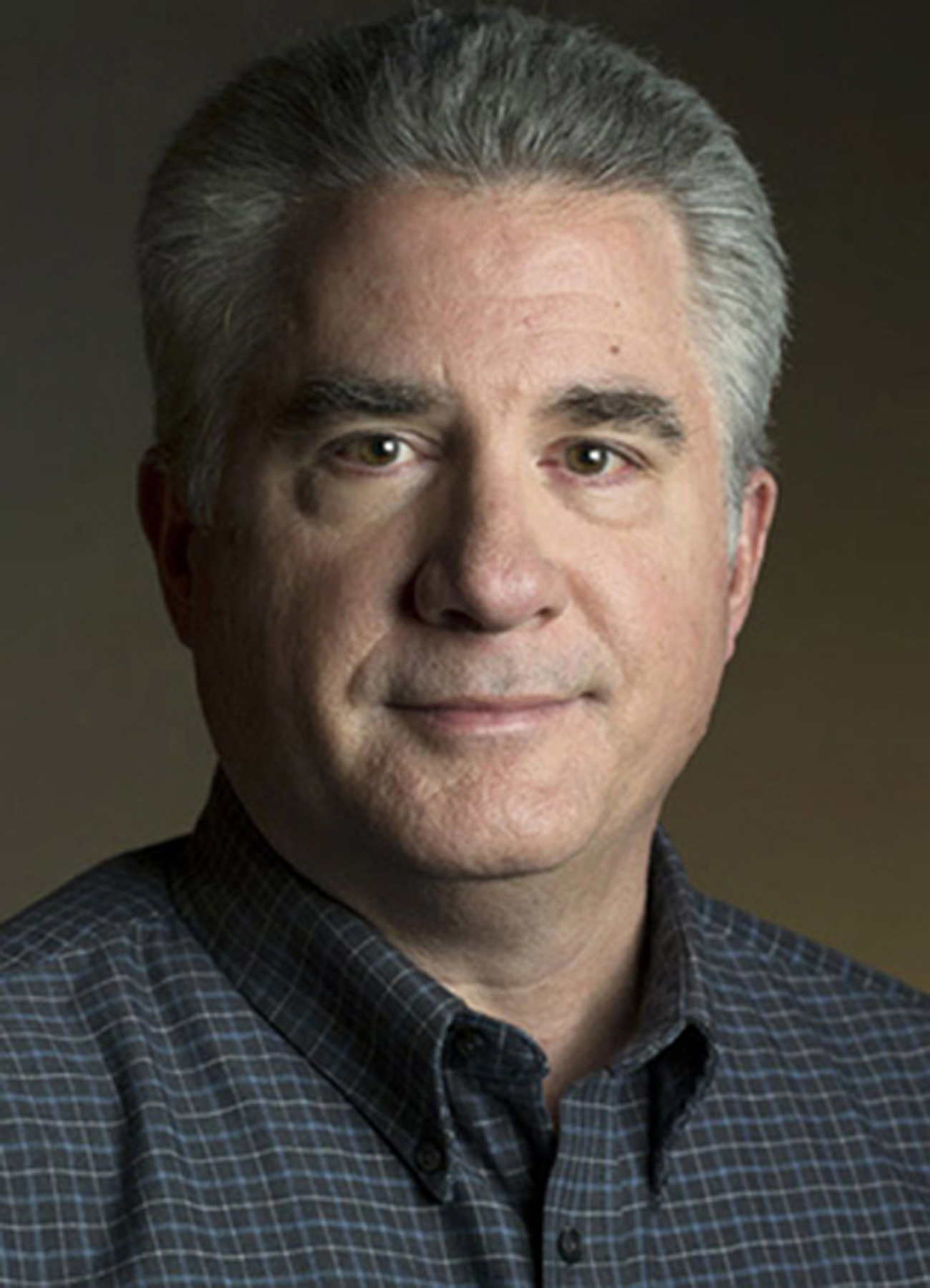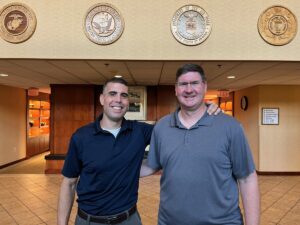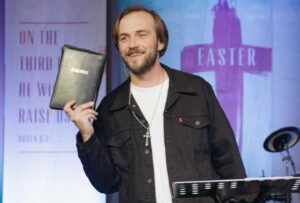
FRESNO, Calif. (BP)–In Hispanic missions and ministries, Southern Baptists across the country are building on the past and birthing the future with a variety of strategies and initiatives.
Efforts to reach Hispanics with the good news that they are loved by God includes:
— In California, strong Hispanic leadership and an emphasis on equipping people at the local level for ministry characterize the strategy of the California Southern Baptist Convention, which is led by Fermin Whittaker, who was born in Panama. His Hispanic origins make him the first and only non-Anglo executive director of a state convention.
Danny Sotelo, the California convention’s newly named coordinator for multi-ethnic evangelism, noted, “There is not one city in California where you will not find thousands of Hispanics. There are more Hispanics in Los Angeles than in any city in Mexico, except for Mexico City.”
His slogan is going to be evangelize or fossilize, Sotelo said.
“One of the things we’re trying to do is equip the people we have in our churches to become personally involved in personal evangelism,” he said. “Our churches need to assume responsibility for their communities. If we do not reach out to new people, we cannot grow new churches, we cannot multiply.”
The state’s first Hispanic congregation — Primera Iglesia Bautista Del Sur in San Jose — was started in 1948. At least 50 new Hispanic congregations were started in California in 2000, Sotelo said, bringing the total to 260, with about 15,000 members.
He credits the assistance of five area Hispanic leaders: Hugo Campos, San Diego; Rodolfo Martinez, Los Angeles; Josias Robledo, San Francisco/Oakland Bay Area; Luisa Rosales, Indio; and Jesse Ureno, Moreno Valley. Anthony Ahaev, a Hispanic from Argentina, is director of the California convention’s language church extension.
The largest Hispanic congregation in the state is White Road Baptist Church in San Jose, where about 600 people worship each Sunday, with Christobal Dona as pastor.
“I think [Dona’s] emphasis is discipling people, and that’s what makes it strong,” Sotelo said. The church also has a Christian school for grades one through 12.
About 300 people gather each Sunday for worship at First Bilingual Baptist Church in Pico Rivera, while about 350 worship at Primera Iglesia Bautista, San Franciso.
Sotelo has planned California’s “first-ever” Hispanic evangelism conference in May, to include preaching — in Spanish — from some of the nation’s most respected Hispanic pastors — Jorge Comesanas, Carlos Navarro and Juan Pistone — plus discipleship evangelism and evangelism targeted for specific age and interest groups.
“I believe the hope of the world is the gospel and the hope of the gospel is the church,” Sotelo said. “As the church begins to move, the gospel is going to be spread out, so the hope of the church is discipleship-making.
“Our evangelism needs to be holistic; it’s not just bringing people to Christ, but leading them to maturity in Christ,” Sotelo said. “The best way to reach them really is to build relationships and then lead them in knowledge of Christ.”
— In Texas, which has 6,045,430 known Hispanics (and like every state, an unknown number of undocumented immigrants), there are 965 Hispanic congregations, including 196 started in 2000. This includes 937 congregations counted by the Baptist General Convention of Texas and 28 counted by the Southern Baptists of Texas Convention.
Texas 2000, a five-year church planting emphasis promoted by BGCT, has yielded 621 new Hispanic congregations, by the BGCT’s count. The BGCT also sponsors Hispanic education. Its Hispanic Baptist Theological School in San Antonio is a training ground designed to equip men and women called to minister in a predominantly Hispanic context. Formerly a “seminary,” it recently re-identified itself a “theological school” in compliance with the Texas legislature, since it offers neither college, university nor graduate-level degrees, said school President Albert Reyes.
“HBTS is in the process of applying for a certificate of authority with the Texas Higher Education Coordinating Board and accreditation with the Accrediting Association of Bible Colleges,” Reyes said. “While the school will continue to offer a non-degree post-secondary theological education, it has plans to offer a B.A. degree in biblical/theological studies. We are committed to becoming a premier equipper of cross-cultural ministry leaders who serve in a multicultural context.”
Otto Arango is pastor at Iglesia Bautista Getsemani, McAllen, Texas, where about 400 people worship in English and Spanish services each Sunday. He also is the BGCT’s coordinator and curriculum developer for 98 Hispanic church planting, ministry learning centers across Texas. The 2,700 students enrolled started at least 225 Hispanic congregations during the last three years, Arango said.
“There is a sense in which the starting of new congregations is outpacing the preparation of trained leadership,” said Daniel Sanchez, Southwestern Baptist Theological Seminary professor of missions and director of the Church Growth Institute at the Fort Worth campus. “The greatest need for education is at the entry level.”
The Southern Baptists of Texas Convention is gearing up for effective ministry among the state’s Hispanics, said Ruben Hernandez, evangelism and missions director/minister for the new convention.
“We are holding a Hispanic leaders’ meeting to help us find the millions of Hispanics in Texas who desperately need the gospel of Jesus Christ,” Hernandez said. “The 16 new missions [started in 2000] are works that our churches have started themselves. We’ve responded to our churches and now with this meeting we want to set strategies to enable us as a convention to be more aggressive in reaching the Hispanic population this year and in the future.”
Evangelist Rudy Hernandez, father of Ruben Hernandez, is president of the Southern Baptists of Texas Convention. “Ninety-five percent of the work among Hispanics is done in the Spanish language and for that reason we will not reach the young people and the young married,” he noted. As an example of the limits to ministering only in Spanish, he added that 57.7 percent of the population in San Antonio speaks English only, while 3 percent speaks Spanish only.
“But we should not go out there just to get numbers,” Rudy Hernandez reminded. “We must hold on to our principles that have made us who and what we are as Baptists — biblically discipling people.”
Iglesia Bautista West Brownsville is one of many successful Hispanic churches. The then-30-member church called Carlos Navarro as pastor seven years ago, and the congregation has since grown to more than 1,000 people in Sunday morning worship. The church also ministers through its radio programming and in Mexico, Spain and Peru.
Northwest Multicultural Church in San Antonio, where Roland Lopez is pastor, would be an excellent example of a church that is successfully reaching second- and third-generation Hispanics, Sanchez said. One of the state’s church-planting training centers is housed at this church.
— In New York, which has an estimated 2,660,685 people of Hispanic origin, there are 36 Hispanic Baptist congregations, 31 of which are in metro New York City.
Romy Manansala, a Filipino, is director of missions for the state convention, while Sanford Bhowmik, a native of Bangladesh who speaks seven languages including Spanish, is the multi-language director. Both men were unavailable as this article was being written. Luis Nieto, a Hispanic and financial accountant for Metropolitan New York Baptist Association, spoke from his vantage point.
“Our goal in this association is to reach 10 percent of the Hispanic population,” Nieto said. “I’m talking about all generations. I’m talking about our grandchildren. We’re trying to reach them, to open new churches, to teach the basic principles of being Christian.
“We need to do a lot of work,” Nieto said. “We need to innovate our programs. We depend too much on the English program [of financial support] for our work. We need to challenge the professionals in our own Spanish communities to do this work.
The “power of the Holy Spirit” is needed in the outreach, “more obedience to the Lord,” Nieto said. “The main key of this ingredient to having success in reaching out to people is to obey him,” he said.
“We need to pray,” he continued. “We need to spend more time on our knees asking, ‘Lord, come to me.’ We need to spend more time being Christian — helping, concerned, loving.”
About 300 people worship in the Washington Heights area of Manhattan at First Spanish Baptist Church, where Freddy Noble is pastor. About 75 percent are from the Dominican Republic, Nieto said.
In West New York, N.J., Paul Flores is pastor at Nazareth Spanish Baptist Church, where about 90 mostly young people worship in English, and 250 others worship in Spanish.
The metro New York association is planning a Jesus 2001 crusade in October in partnership with churches from the Dallas Baptist Association in Texas, Nieto said. The Spanish-culture crusade will be translated sentence by sentence into Spanish and English.
“Sometimes we need to trust people,” Nieto said of Baptists’ witness. “This is my personal opinion. You need to talk to people you see on the street. We cannot do anything here when we are afraid to reach out to the people who are here.”
— In Florida, where there are 2,334,403 known Hispanics, there are 224 Hispanic congregations in the Florida Baptist Convention; 22 were started in the last year. Frank Moreno is the convention’s strategist for Hispanic and international church planting.
“I was in a Colombian restaurant last week with a pastor,” Moreno said. “When we got our ticket, I said, ‘Let me ask you something. Has anyone told you God loves you?’
“She was astonished,” Moreno continued. “She said no, and that she had looked in the Yellow Pages for a church just that Sunday, but didn’t know which one was near her.”
The pastor with Moreno happened to be from her neighborhood.
“We need to take advantage of every opportunity to witness to Hispanics and tell them how much the Lord loves them,” Moreno said. “Some people do not know how to approach Hispanics. It’s not the same thing to minister to a person from Central America as a person from the Caribbean. You cannot use the same strategy to reach every Hispanic group; it must be tailor-made.”
Florida has three regional missionaries who reach out to all ethnics, and one more who has statewide responsibility for people from Haiti. Another 10 serve under contract to start new work among ethnic churches, Moreno said. In addition, several thousand people are being trained through seven or eight theological study centers and four church starting institutes.
“The advantage we have in Hispanic ministry is a common language and history,” Moreno said. “Even though the language has variances, we can understand each other.”
The Florida Baptist Convention recently commissioned a study which found that the gospel has had very little impact in Dade County, said David Lema, the Miami Baptist Association’s director of Hispanic ministries.
“When we talked specifically about Hispanics, we found 80 percent do not know how to become a Christian,” Lema said. “A lot of them are very confused. They think they’re a Christian because they’re a good person.”
In Dade County, 53 percent of the residents can be contacted at their door, according to the study, Lema said.
“The statistics show people will like a personal encounter, and specifically Hispanics because they are very social,” he said. “They would have more inclination to a personal encounter than mass mailing, radio or television. Some of our churches have taken that information and run with it.
“Personal distribution of the ‘Jesus’ video has been very successful here,” Lema continued. “The churches have had a very positive response of people coming to the church who were given a copy of the video by the church.”
Among the state’s successful Hispanic congregations is First Baptist Church of Coral Park, near Miami, where about 6,000 people worship each Sunday.
“In some of our large Anglo churches, a large percentage of their membership is young, English-speaking Hispanics,” Lema said. “These churches have made accommodation.” That accommodation has been cultural rather than doctrinal, Lema added.
“Particularly the new generations are looking for truth,” Lema said. “If the church doesn’t stand for truth, I can’t care how much marketing it does, it won’t stand. The people who come to the churches are actually probing.”
Bill White, pastor at Miami’s University Baptist Church, has led his church to publish “Beyond the Cultural Walls: Toward Transcultural Understanding” based on Romans 12:2.
“They launched from there to transcultural understanding,” Lema said. “They talk about generations — and they’re aiming for the young ‘buster’ generation. Their concept is to try to blend styles that will relate to all generations or cultures in a single service — fostering the acceptance of people traveling in ‘tribes’ — allowing them to form community from the larger group with the affinity group that feels most real to them.”
Jorge Comesanas is pastor at Primera Bautista Iglesia Coral Park, one of the congregations in Florida that has successfully linked sound doctrine with exuberant, celebratory worship, Lema said.
— In Colorado, where its 603,582 Hispanics place the state ninth in the country in Hispanic population, one out of every seven Southern Baptist churches is Hispanic, said Eliseo Aldape, director of the Baptist convention’s ethnic church extension ministries. “We started probably nine new works last year, and have 43 Hispanic congregations in all,” he noted.
“The churches are using cell groups to start new works,” Aldape continued. “Most of our congregations are using this strategy. Personal street evangelism is another, [along with] school or Bible study forums and crusades.”
Colorado has two ethnic leadership development study centers, in Grand Junction on the western slope of the Rocky Mountains and at Riverside Baptist Church in Denver to the east. A third center at the state convention offices is expected to be operational by next year.
“We started this last year — three Hispanic missions coordinators who serve under their associational director of missions,” Aldape said. “The purpose is to stabilize leadership on the field. Leadership is very scarce in Colorado. We supplement their income a bit to do coordination, and they are beginning to develop leadership at the ground roots level. Each of them has a goal of beginning 10 new churches within the next three years.”
The coordinators serve in Alamosa and the San Luis Valley, one of the state’s most economically depressed areas; Longs Peak area, including Fort Collins; and in the southeastern part of the state, which includes La Junta and Lamar.
From Colorado to the East and West coasts, said Bob Sena, manager of the Southern Baptist North American Mission Board’s Hispanic church planting unit, more remains to be done in Hispanic outreach because of the continual immigration of Hispanics who do not know Jesus Christ as their personal Lord and Savior and because of those who have not yet been reached.
“Without excluding our concern for all ethnic groups, we need to somehow re-vision the mission and concern for reaching this growing Hispanic population segment of our nation,” Sena said. “A gigantic proportion of them are lost and without Jesus. They have no purpose, no hope, no direction, no Christ, no church. We have a mandate from God to reach out to them.”
–30–


